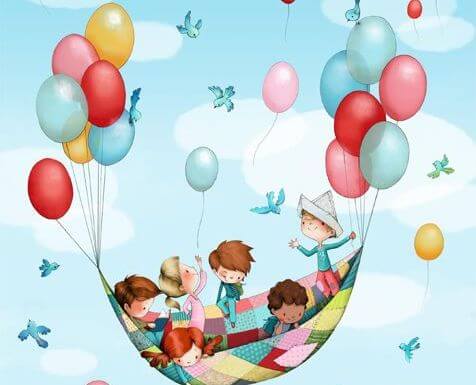9 Relaxation Games to Raise Emotionally Strong Children

In an era where tablets are used to keep children busy, it has become even more indispensable to train our little ones in relaxation techniques. We can do it through games so that, as they develop resources and life skills, they will also have fun.
We live in a society that promotes hurrying, quick stimuli and immediate gratification. So, it’s of utmost importance that we have resources at hand which favor a greater sense of self-control.
That’s why, based on this premise, in this article we have compiled some games that serve as relaxation techniques for the youngest members of your family. Let’s see what they are:
1. Blow out the candle!
This game consists in learning to breathe deeply. That is to say, taking in air through the nose, filling up one’s tummy and blowing out the air slowly while you try to blow out the candle. Once the instructions are understood, you sit the child in a chair two meters away from the candle. This candle will be lit and situated on top of a table.
The child can’t get up or lean forward. Thus, it’s to be expected that he not be able to blow out the candle. So, you scoot him closer about half a meter. You will scoot him gradually closer until he is able to blow the candle out. This way, you’ll be able to play for at least 5 minutes, during which the child will acquire the ability to breathe in and out deeply.

2. The balloon game
The balloon technique is a marvelous game that helps us promote relaxation through correct breathing. What do you need? A wide open space and colored balloons. What do you need to do? Blow up a balloon to the point that it explodes and blow up another one, later letting it deflate slowly by manipulating the opening.
Then, ask the children to close their eyes and pretend they are balloons. Ask them to fill themselves with air, inhaling deeply. Then you’re going to ask them to let out the air slowly, as if they were like the second balloon.
After doing this, ask the children to tell you about situations in which they felt like balloons. Times during which they couldn’t stand or tolerate something. Then, invite them to tell you about how they resolved the situation. Also, offer alternatives if they need help gaining awareness in these situations.

3. Progressive relaxation
Though we could tell you the instructions of this technique, there’s a video on Youtube based on the original text of Koeppen relaxation, which narrates the relaxation steps with fantastic background music, courtesy of Salvador Candel. Nevertheless, we could also provide you with the instructions, setting the mood with relaxing music that will favor a warm and tranquil environment.
As an additional note, if you get nervous during class you could do the following. Grab onto the chair that you are sitting in and tense up your arms and torso as you push your feet into the ground.
4. The seed game
With relaxing background music and dim lighting, we will symbolize the growth of a tree. We’ll start on our knees, on the ground, with your head bend downwards. Your arms will be extended forwards, as if you were a kitten waking up.
We are a seed that, to the beat of the music, starts growing and becoming a big tree with beautiful branches. These will be our arms, extended upwards when we rise to our feet. This is an ideal exercise to perform with them at night, right before tucking them into bed.

5. The story of the turtle
The story of the turtle, developed by Schneider, is magnificent for encouraging self-control skills. It tells the tale of a small turtle that got angry over everything and lost his temper easily.
One day, after feeling alone and isolated, it finds a wise turtle that shares with him a trick to controlling himself when he got angry. He told the turtle to go into its shell and count until he calmed down. To pause his thoughts and relax.
This story is ideal for children between the ages of 3 and 7 years old. In order to promote the use of this skill, we can give them a sticker or a small piece of paper with a turtle on it every time they carry out the exercise during a tense situation. We have it available and ready for you to download and print here.
6. The calm jar
By “The Calm Jar” we’re referring to a bottle that we fill with water, some liquid silicone to give the content some density, and something flashy. Like, for example, glitter. We can make it with the kids, as simply another arts and crafts project. It is ideal for them to contemplate during tense moments, as well as moments that we could refer to as “zen”.
The point is for them to shake it up and observe the movement. We will then explain to them that the glitter is their emotions. They get all shook up, until they calm and settle down. It is an ideal way to encourage moments of reflection.
7. The giant floating ball game
This game is another resource used to have fun and learn how to breath deeply. It consists in having the children keep the ball in the air as long as they possibly can. Fun, right? The truth is that this game is always a favorite, and it is very handy in promoting relaxation.

8. Wrinkling up papers, squeezing balls, and doodling
Doodling, wrinkling up papers or squeezing balls like the anti-stress kind is another marvelous game that can help children channel their negative emotions. Also, at the same time you are encouraging the development of their fine motor skills. Because these games help them strengthen the muscles in their little hands.
9. Drawing mandalas
Drawing mandalas not only favors relaxation and reflection, but also the ability to concentrate and their creative skills. In libraries and on the internet, you can find various appropriate alternatives that your children will love.

This is as far as our compilation goes today. We hope that these games and resources will truly be of help in the raising of your little ones. Let’s not forget that it is easier to raise strong children than it is to repair broken adults. Nature entrusts us with the education of children, and this is our biggest responsibility.
This text is provided for informational purposes only and does not replace consultation with a professional. If in doubt, consult your specialist.








